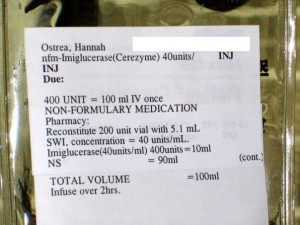 Can you believe it has been three months since Hannah’s first Cerezyme treatment?!
Can you believe it has been three months since Hannah’s first Cerezyme treatment?!
Hannah had her seventh IV infusion today, and she really handles it like a champ. The only issue today was that we had to wait over TWO HOURS for the pharmacy to deliver the Cerezyme to the Infusion Center. What a pain in the butt!
She also had very important bloodwork taken before her infusion after her IV was set. These would test her Gaucher markers and CBC (platelet count!) to see if her enzyme replacement therapy has been helpful in her body (we already know it doesn’t cross the blood-brain barrier). We should get the results of the platelets in a day or two, but we won’t see the results from the Gaucher markers for about a month.
I really, really, really, really hope we see some improvement in her markers. This would mean there is purpose for the Cerezyme. We honestly already feel that her spleen and liver have started to go down, but that is totally subjective, and I admit, a bit of wishful thinking. But you know me, I’m a realist, and I really think it has helped some.
 Over the years, I have met some wonderful people online who have become an some of my closest friends. Being able to meet them in person, even just once, has helped solidify friendships that have lasted almost a decade.
Over the years, I have met some wonderful people online who have become an some of my closest friends. Being able to meet them in person, even just once, has helped solidify friendships that have lasted almost a decade. In a study that reveals the clearest picture to date of neuron death in Parkinson’s disease, researchers at Columbia University Medical Center have found that a trio of culprits acting in concert is responsible for killing the brain cells.
In a study that reveals the clearest picture to date of neuron death in Parkinson’s disease, researchers at Columbia University Medical Center have found that a trio of culprits acting in concert is responsible for killing the brain cells.
Latest Comments